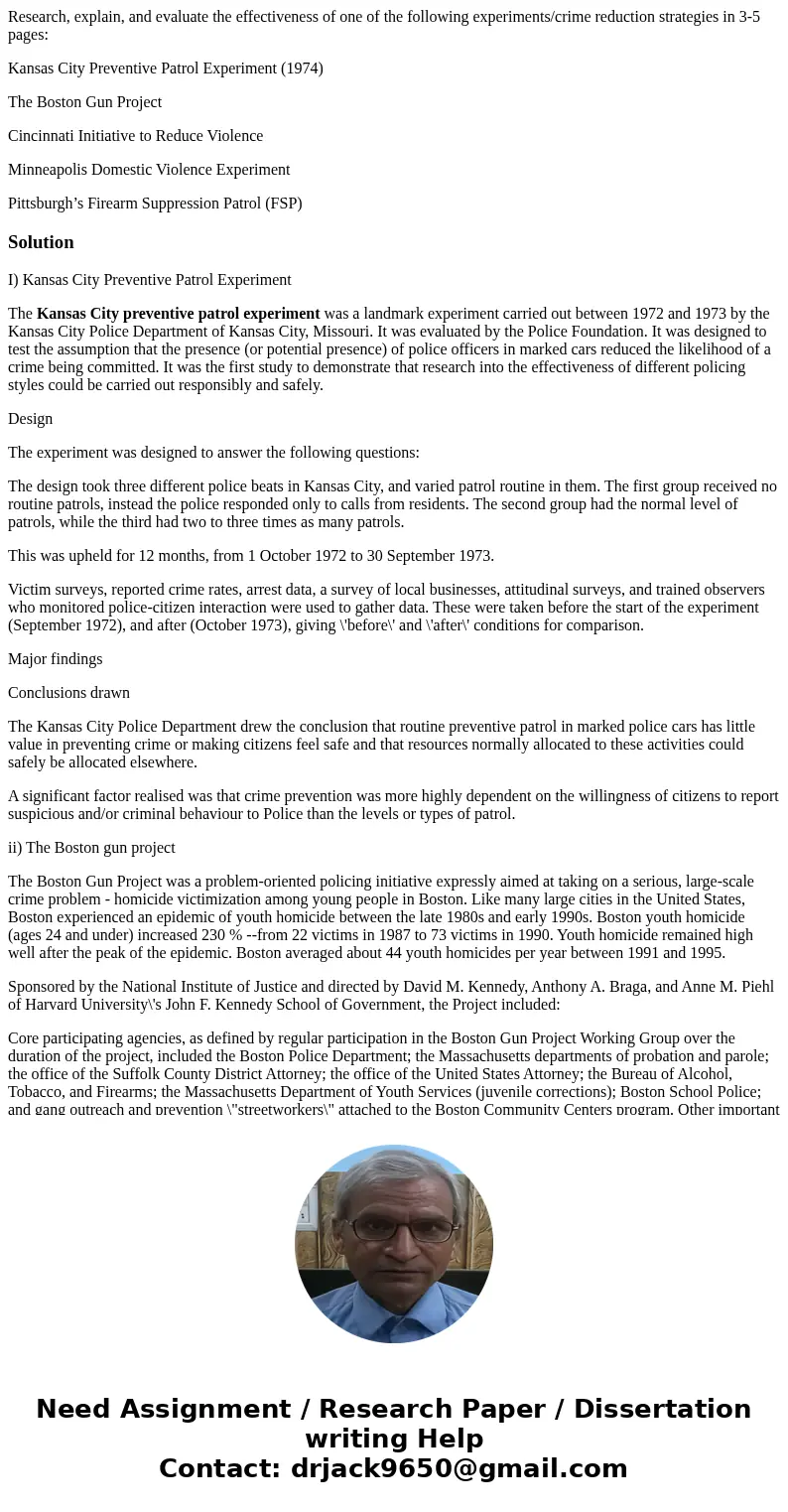Research explain and evaluate the effectiveness of one of th
Research, explain, and evaluate the effectiveness of one of the following experiments/crime reduction strategies in 3-5 pages:
Kansas City Preventive Patrol Experiment (1974)
The Boston Gun Project
Cincinnati Initiative to Reduce Violence
Minneapolis Domestic Violence Experiment
Pittsburgh’s Firearm Suppression Patrol (FSP)
Solution
I) Kansas City Preventive Patrol Experiment
The Kansas City preventive patrol experiment was a landmark experiment carried out between 1972 and 1973 by the Kansas City Police Department of Kansas City, Missouri. It was evaluated by the Police Foundation. It was designed to test the assumption that the presence (or potential presence) of police officers in marked cars reduced the likelihood of a crime being committed. It was the first study to demonstrate that research into the effectiveness of different policing styles could be carried out responsibly and safely.
Design
The experiment was designed to answer the following questions:
The design took three different police beats in Kansas City, and varied patrol routine in them. The first group received no routine patrols, instead the police responded only to calls from residents. The second group had the normal level of patrols, while the third had two to three times as many patrols.
This was upheld for 12 months, from 1 October 1972 to 30 September 1973.
Victim surveys, reported crime rates, arrest data, a survey of local businesses, attitudinal surveys, and trained observers who monitored police-citizen interaction were used to gather data. These were taken before the start of the experiment (September 1972), and after (October 1973), giving \'before\' and \'after\' conditions for comparison.
Major findings
Conclusions drawn
The Kansas City Police Department drew the conclusion that routine preventive patrol in marked police cars has little value in preventing crime or making citizens feel safe and that resources normally allocated to these activities could safely be allocated elsewhere.
A significant factor realised was that crime prevention was more highly dependent on the willingness of citizens to report suspicious and/or criminal behaviour to Police than the levels or types of patrol.
ii) The Boston gun project
The Boston Gun Project was a problem-oriented policing initiative expressly aimed at taking on a serious, large-scale crime problem - homicide victimization among young people in Boston. Like many large cities in the United States, Boston experienced an epidemic of youth homicide between the late 1980s and early 1990s. Boston youth homicide (ages 24 and under) increased 230 % --from 22 victims in 1987 to 73 victims in 1990. Youth homicide remained high well after the peak of the epidemic. Boston averaged about 44 youth homicides per year between 1991 and 1995.
Sponsored by the National Institute of Justice and directed by David M. Kennedy, Anthony A. Braga, and Anne M. Piehl of Harvard University\'s John F. Kennedy School of Government, the Project included:
Core participating agencies, as defined by regular participation in the Boston Gun Project Working Group over the duration of the project, included the Boston Police Department; the Massachusetts departments of probation and parole; the office of the Suffolk County District Attorney; the office of the United States Attorney; the Bureau of Alcohol, Tobacco, and Firearms; the Massachusetts Department of Youth Services (juvenile corrections); Boston School Police; and gang outreach and prevention \"streetworkers\" attached to the Boston Community Centers program. Other important participants, either as regular partners later in the process or episodically, have included the Ten Point Coalition of activist black clergy, the Drug Enforcement Administration, the Massachusetts State Police, and the office of the Massachusetts Attorney General.
The Project began in early 1995 and implemented what is now known as the \"Operation Ceasefire\" intervention, which began in the late spring of 1996. Operation Ceasefire was an innovative partnership between researchers and practitioners brought together to assess the city\'s youth homicide problem and implement an intervention designed to have a substantial near-term impact on the problem. Operation Ceasefire was based on the \"pulling levers\" deterrence strategy which focused criminal justice attention on a small number of chronically offending gang-involved youth responsible for much of Boston\'s youth homicide problem. The Program in Criminal Justice performed a rigorous evaluation of the project.
Our impact evaluation suggests that the Ceasefire intervention was associated with significant reductions in youth homicide victimization, shots fired calls for service, and gun assault incidents in Boston. A comparative analysis of youth homicide trends in Boston relative to youth homicide trends in other major U.S. and New England cities also supports a unique program effect associated with the Ceasefire intervention.
iii) The Cincinnati Initiative to Reduce Violence (CIRV)
The Cincinnati Initiative to Reduce Violence (CIRV) is a multi-agency and community collaborative effort initiated in 2007 designed to quickly and dramatically reduce gun-violence and associated homicides, with sustained reductions over time. The initiative is a focused-deterrence strategy which is modeled after the Boston Gun Project from the mid-1990s.
A partnership among multiple law enforcement agencies (local, state and federal), social service providers and the community has been established to deliver a clear message to violent street groups: the violence must stop. This message is communicated through a number of different mechanisms, including call-in sessions with probationers and parolees; direct contact through street workers (street advocates), police, probation, and parole officers; community outreach; and media outlets.
Law enforcement agencies have gathered intelligence on violent street group networks, and consequences are delivered to the street groups that continue to engage in violence. Those offenders seeking a more productive lifestyle are provided streamlined social services, training, education, and employment opportunities. The community and law enforcement are working as partners and as a result, strengthening their relationship. Since 1998, homicides steadily increased, reaching a modern-day high of 89 homicides in 2006, with an average of 73.3 homicides per year from 2001 to 2006.
CIRV\'s Impact
CIRV is specifically designed to impact gun-related violence in a target population (chronic violent offenders affiliated with street groups). In 2007, homicides declined to 68 -- biggest single-year decline in homicides since 1991.
Reduction in the cumulative homicide count began in April 2007 and continued throughout the year. While not definitive, this decrease is consistent with the expected reductions in violence commonly associated with this type of focused deterrence strategy. Full evaluation of CIRV impact cannot be assessed for 12-18 months.


 Homework Sourse
Homework Sourse